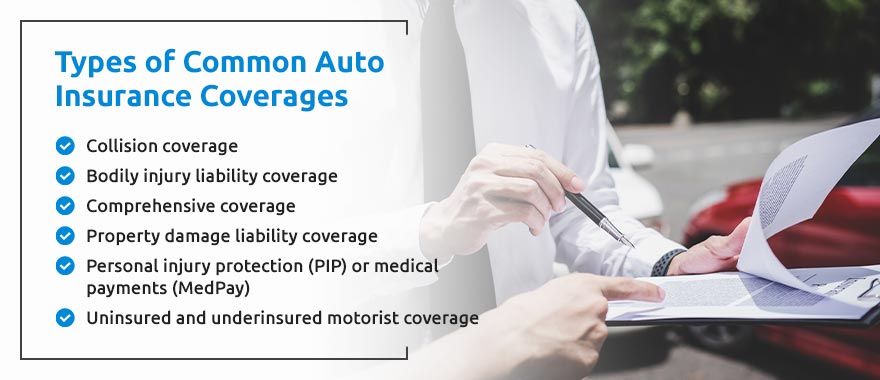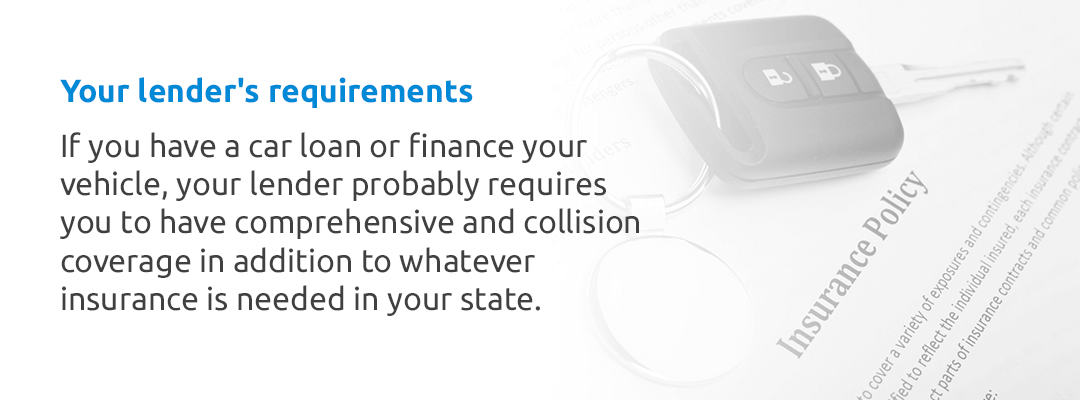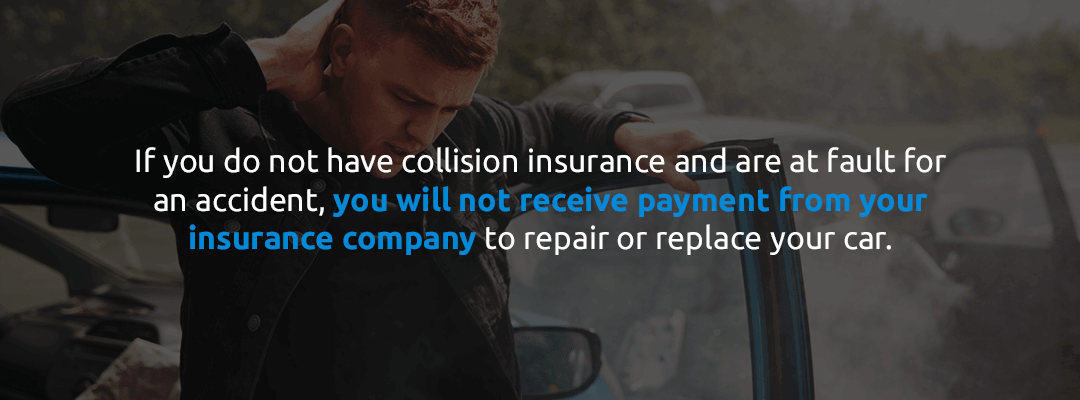Chapter 3: Determining My Insurance Needs
If you drive a Lamborghini, you’ll need different insurance than a teenager who just bought a used Toyota. Car insurance is not a one-size-fits-all solution, and your policy should be tailored. Before you sign up for an insurance plan, figure out what you need to make an informed choice and get the best deal.
In this chapter, we’ll give you a hand and show you factors to consider when determining your insurance requirements. If you want an expert to provide recommended car insurance coverage, let us know at David Pope Insurance.

Types of Common Auto Insurance Coverages
Your insurance provider will offer a few types of coverage that you can include in your car insurance policy, such as:
- Collision coverage: Collision coverage applies to damage to your car when you cause an accident with an object or another car. Lenders tend to require collision coverage for auto loan borrowers.
- Bodily injury liability coverage: Bodily injury liability covers you when another driver is injured in an accident for which you are at fault. This coverage pays for the other driver’s medical bills. In Missouri, you’re required to have coverage of $25,000 per person and $50,000 per accident. However, we recommend at least $100,000 of bodily injury liability coverage per person and $300,000 per accident.
- Comprehensive coverage: Comprehensive coverage is used to pay for damage to your vehicle from a cause other than an accident, such as a flood, fire, theft or hail.
- Property damage liability coverage: Property damage liability coverage applies to damage you have caused to someone else’s property in an accident.
- Personal injury protection (PIP) or medical payments (MedPay): Personal injury protection (PIP) or medical payments (MedPay) coverage pays for the cost of your and your passengers’ injuries. Sometimes this coverage also includes lost wages as a result of these injuries.
- Uninsured and underinsured motorist coverage: Underinsured motorist coverage and uninsured motorist coverage covers you if you’re in an accident with a driver who lacks adequate insurance or lacks insurance altogether. In Missouri, you’re required to carry at least $25,000 of uninsured motorist coverage per person and $50,000 per incident. Underinsured motorist coverage is not required in Missouri.
The coverages that you are required to carry vary by state and lender if you have a lease or auto loan. Beyond requirements, you may also want to make sure you have additional coverage for adequate protection.
How Much Auto Insurance Do I Need?
Some people choose the cheapest insurance they can find, while others select coverage they don’t really need. It’s worth it to carefully consider your unique situation and think about what you’ll be glad to have if you’re in an accident. Factors that affect car insurance needs include:
- State requirements: Consider what you need to comply with state laws. Not having insurance could lead to penalties. In Missouri, if a driver is convicted of not having proof of insurance, they will gain points on their driving record, and the court may suspend their driving privilege. The Insurance Information Institute lists the coverage requirements by state.
- Your lender’s requirements: If you have a car loan or finance your vehicle, your lender probably requires you to have comprehensive and collision coverage in addition to whatever insurance is needed in your state. It may also require higher liability limits than the state minimum with a loan.
- Deductibles you can afford: Your car insurance deductible is the amount you’ll pay out of pocket before your insurance takes over. Usually, the higher the deductible, the lower your premium. Whether you should choose a high deductible to save money on your premium depends on a few factors. If you can’t afford a $1,000 deductible, for example, then it doesn’t make sense to pay for a deductible that high. If you have enough money saved up for a higher deductible, you might choose a lower premium.
- Your driving habits: Take an honest look at your driving habits and your history as a driver. Do you tend to speed? Have you locked your keys in your car more than once? If you feel more comfortable having collision insurance after reflecting on your past, it’s probably worth getting if you can afford it. On the other hand, if you’re a cautious and aware driver, you might feel safe with the minimum coverage.

- Your financial situation: What does your savings account look like, and how many assets do you have? As mentioned, it’s ideal to choose enough insurance to protect your assets. If you cause a bad accident and don’t have adequate coverage, the other party can sue you to receive payment for injuries or damage. The more you have, the more you can lose. Also, think about how much money you have to help you in an accident, and whether you’ll need extra protection.
- Your vehicle: Think about the type of car you drive and its value. Imagine you drive a vehicle that’s worth $1,000. If you opt for collision insurance with a $500 deductible, you’ll be able to replace your $1000 car with a $500 vehicle. Now imagine collision insurance costs you $400 a year. Taking this into account, you’d be left with $100 for a car replacement. Is this number worth paying for the extra coverage? Probably not. However, if your vehicle is worth $20,000, it makes a lot more sense to get collision.
- How often you drive: If you only use your car to drive to the grocery store in town once a week, you may not need a full-coverage policy. If you use your vehicle to commute to your full-time job, you may be at a higher risk of an accident and should consider more coverage.
- Your location: Think about where you live and if the area is prone to theft, vandalism, severe weather and other elements that could damage your car. For instance, do you live in a rural area and often have to slam on your brakes for deer? If so, it might make sense to get comprehensive coverage.
- If you need extras: Consider optional coverages and if they’ll bring you peace of mind. Some options only add a few dollars a month to your premium. For example, basic roadside assistance may cost around $30 a year, depending on your carrier.
- Limits you’re comfortable with: Lastly, think about auto insurance coverage limits you feel comfortable with. Are you all right with a bodily injury liability limit of $50,000 per accident, or would you feel more assured with a higher limit and a higher premium? If you’re unsure about which limits to choose, you can always ask your insurance agent for their advice.
How Much Property Damage Coverage Should I Get?
When it comes to property damage liability, you can either get your state’s minimum amount or the highest amount you can afford. As mentioned in the previous chapter, you’ll need $25,000 liability coverage per accident for property damage in Missouri. If you live in a nearby state, you might face different requirements. For example, if you live in Iowa, you’ll need $15,000 liability coverage for property damage.
Although the average claim might fall within your policy limits if you have the state minimum coverage, consider what would happen if you totaled someone’s brand new car. According to Kelly Blue Book, a new, luxury midsize car might cost $55,000. With only $25,000 liability coverage for property damage, you’d be left to pay $30,000 out of pocket.
Therefore, it’s recommended you purchase as much liability insurance as you can afford. Typically, property damage liability goes up to $100,000. Increasing this limit from the state minimum may only raise your premium by a couple of dollars a month, depending on where you live and your driving history.
Do I Need Collision Insurance in My State?
You are not required to carry collision insurance in any state. You can check this chart of state requirements to see what you need.
What Happens If You Have No Collision Insurance?
Collision insurance covers repairs to your vehicle after an accident, no matter who’s at fault. If you lack collision coverage and are responsible for the accident, you will not receive payment from your insurance company to fix or replace the car. You will also not receive compensation if an uninsured driver hits you unless you have uninsured motorist property damage coverage — which may or may not be available by your insurance carrier.

When the other party is considered to be at fault and has adequate insurance, their policy should cover the damages to your vehicle, regardless of whether you have collision insurance.
How to Choose the Best Deductible
A deductible is how much you will pay out-of-pocket when you file a claim. Though there isn’t a deductible on your liability insurance, you’ll pay a deductible for your collision and comprehensive coverages. Typically, if you choose a higher deductible, you’ll pay less per month for your car insurance premium. If you do select a higher deductible, be sure to keep that amount in savings in case you have to file a claim.
However, in some cases, you may be better off choosing a lower deductible. For example, if you don’t have emergency funds to cover your deductible or repairs or you drive an older, lower-value car, you may want to opt for a lower deductible.
Where Can I Find an Insurance Needs Calculator?
Various insurance companies might offer an insurance needs calculator online, or you can try to figure out what you need on your own. To calculate how much insurance you need, consider the following:
- Your net worth
- Vehicle age
- The deductible you can afford
- Whether you own or finance your vehicle
- If you’re more interested in the most affordable option or the highest protection
You can also request a quote at David Pope Insurance, and we’ll point you in the right direction.



